
Magento 2 Returns Management: How To Manage RMA Requests
Are you looking to enhance your customer service experience? Magento 2 Returns Management (RMA) is your solution. This system streamlines managing return requests and exploring various use cases. It simplifies the return process for both businesses and customers. It ensures satisfaction and efficiency.
This article will cover how to implement Magento 2 product return Management. It will also discuss how to optimize this process.
Key Takeaways
-
What Is Magento 2 Returns Management?
-
Why Effective Returns Management is Important for Your Magento 2 Store
-
How To Manage Magento 2 RMA Requests
-
Use Cases of Magento 2 RMA Extension
-
Best Practices for Effective Magento 2 Management
What Is Magento 2 Returns Management?
Magento 2 Returns Management is a necessary system for e-commerce stores. It handles product returns efficiently.
Returns Management process is important for customer satisfaction and inventory control. A smooth return process can improve customer experience. It can turn a potentially negative situation into a positive one.
For example, a customer might receive a damaged item. An easy return process can restore their faith in the store. Quick resolution of returns builds trust. Customers appreciate knowing they can easily return items. This knowledge makes them more likely to make future purchases.
Accurate tracking of returns helps maintain correct stock levels. It prevents overselling items. It also prevents understocking items. Proper tracking allows businesses to identify quality issues. For instance, many customers might return a specific product. If they all cite the same reason, it could indicate a manufacturing problem.
The Returns Management system in Magento 2 uses Return Merchandise Authorization (RMA). RMA is a formal way to process returns. It helps track and manage return requests.
Why Effective Returns Management is Important for Your Magento 2 Store
1. Customer Satisfaction
-
An easy returns process encourages customer loyalty. A one-click RMA initiation process reduces friction. Customers are more likely to make future purchases if they know returns are hassle-free. The system remembers customer details and order history, pre-filling information for faster returns.
-
Clear return policies build trust with shoppers. Prominently displayed, easy-to-understand return policy on product pages and checkout. Reduces hesitation in making purchases, especially for first-time customers. The system allows for dynamic policy display based on product type or category.
-
Efficient handling of returns improves the overall shopping experience. It automates email updates on return status. It keeps customers informed, reducing anxiety and support inquiries. The system triggers notifications at key stages (RMA approved, refund processed, etc.).
2. Operational Efficiency
-
A streamlined return process reduces the workload on staff. It automates sorting of returns based on reason codes. Staff can process returns faster, focusing on complex cases that need human intervention. The system uses return reason codes to route items to appropriate departments (resale, repair, disposal).
-
An automated RMA system minimizes errors. They are system-generated RMA numbers linked to original orders. It reduces mix-ups and lost returns, improving accuracy in refunds and exchanges. Each RMA is tied to the original order data, ensuring correct product and pricing information.
-
Proper tracking of returned items improves ecommerce inventory management. Real-time updates to inventory levels as returns are processed. It prevents overselling of returned items and allows for quicker restocking. The system automatically adjusts inventory counts based on the condition and disposition of returned items.
3. Financial Benefits:
-
Well-managed returns can lead to exchanges instead of refunds. It offers exchange options with incentives (e.g., free shipping on exchanges). This retains revenue and potentially increases order value. The system presents personalized exchange options. These are based on the customer's purchase history. They also consider current inventory.
-
Efficient processing reduces costs associated with returns. This includes batch processing of returns. It also involves automated refund issuance. This approach reduces labor costs. It also improves cash flow management. The system groups similar returns. This allows for efficient processing. It automatically issues refunds for eligible returns.
-
Data from returns can inform product improvement decisions. This involves detailed reporting on return reasons. Reports can be by product, category, or supplier. This helps identify quality issues. It can also reveal misaligned product descriptions. These insights lead to improvements. The system aggregates return data. This allows for trend analysis. It also enables automatic flagging of products with high return rates.
How To Manage Magento 2 RMA Requests?
1. Viewing and Editing RMA Requests
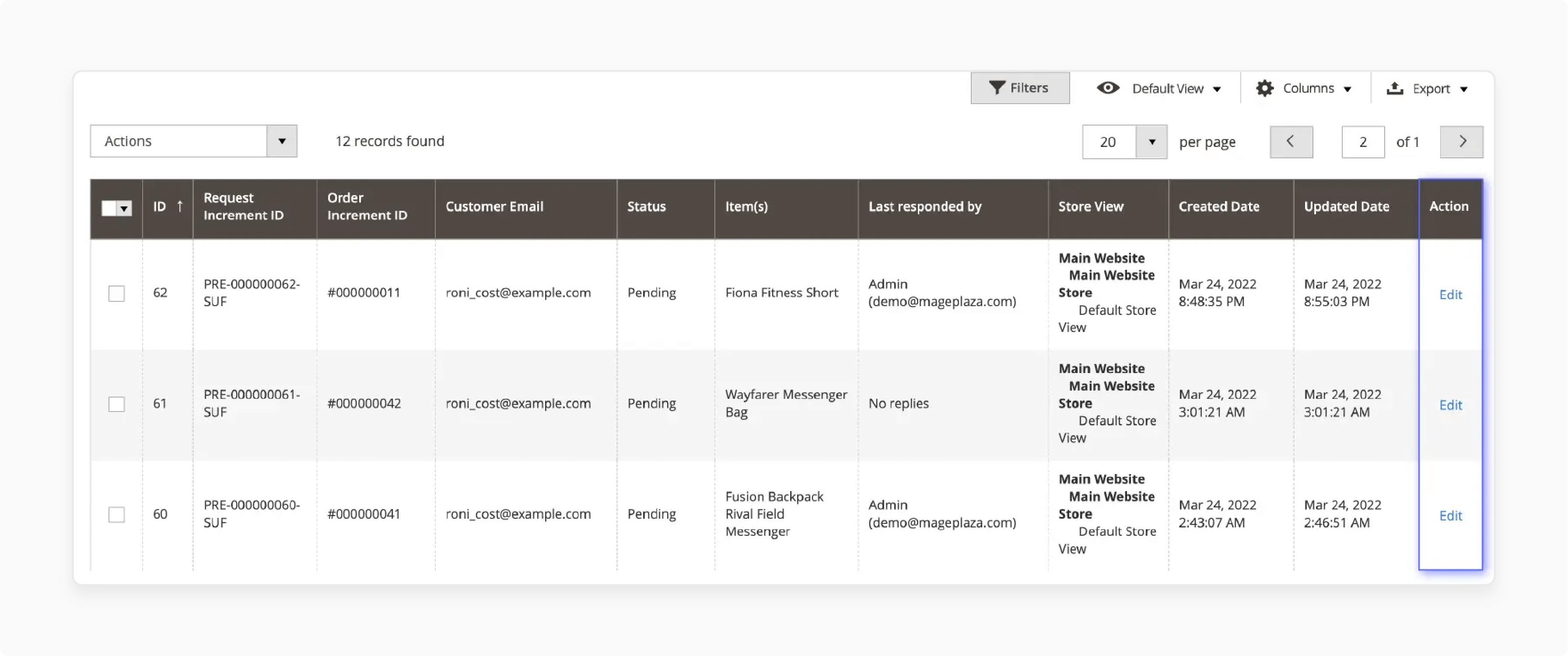
-
Access the admin panel and navigate to the RMA module.
-
View a list of all RMA requests, sortable by order date, order ID, or status.
-
Click on a specific RMA to view details such as:
-
Original order information
-
Products requested for return
-
Customer's reason for return
-
Current status of the RMA
-
-
Edit RMA details as needed, including:
-
Updating product quantities
-
Modifying return reasons
-
Adjusting refund amounts
-
2. Communicating with Customers through Magento 2 RMA System
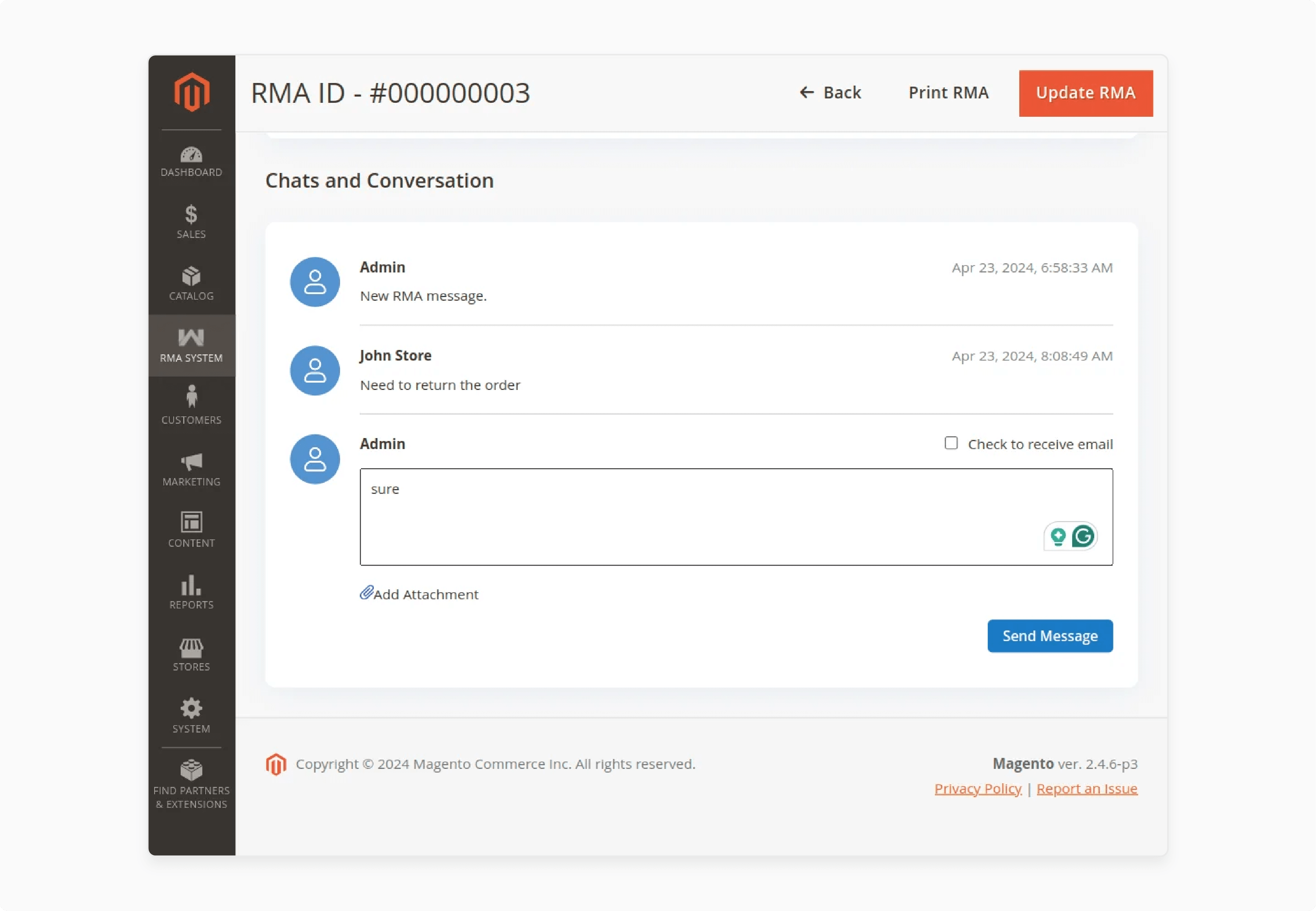
-
Use the built-in messaging system to communicate directly with customers.
-
Send updates about the RMA status or request additional information.
-
Maintain a record of all communications within the RMA request for easy reference.
-
Set up automated email notifications to keep customers informed about their return's progress.
3. Updating RMA Status and Resolution in Magento 2
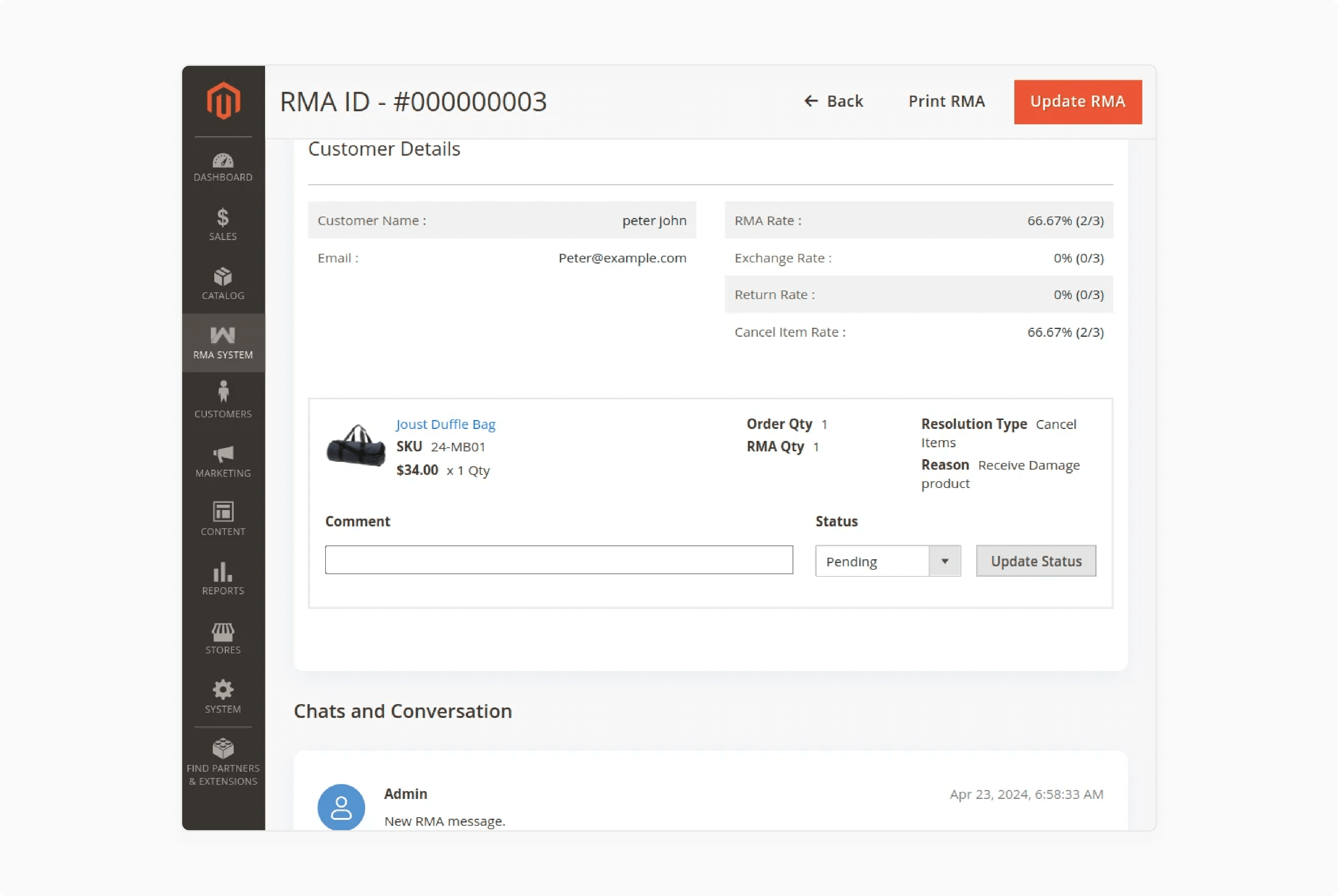
-
Change the RMA status as it progresses through the return process:
-
Pending
-
Authorized
-
Received
-
Processed
-
Closed
-
-
Process refunds or exchanges directly through the RMA module.
-
Generate return shipping labels if required.
-
Update inventory levels automatically upon successful return processing.
-
Close the RMA once the return or exchange is complete.
Use Cases of Magento 2 RMA Extension
1. Return ordered items
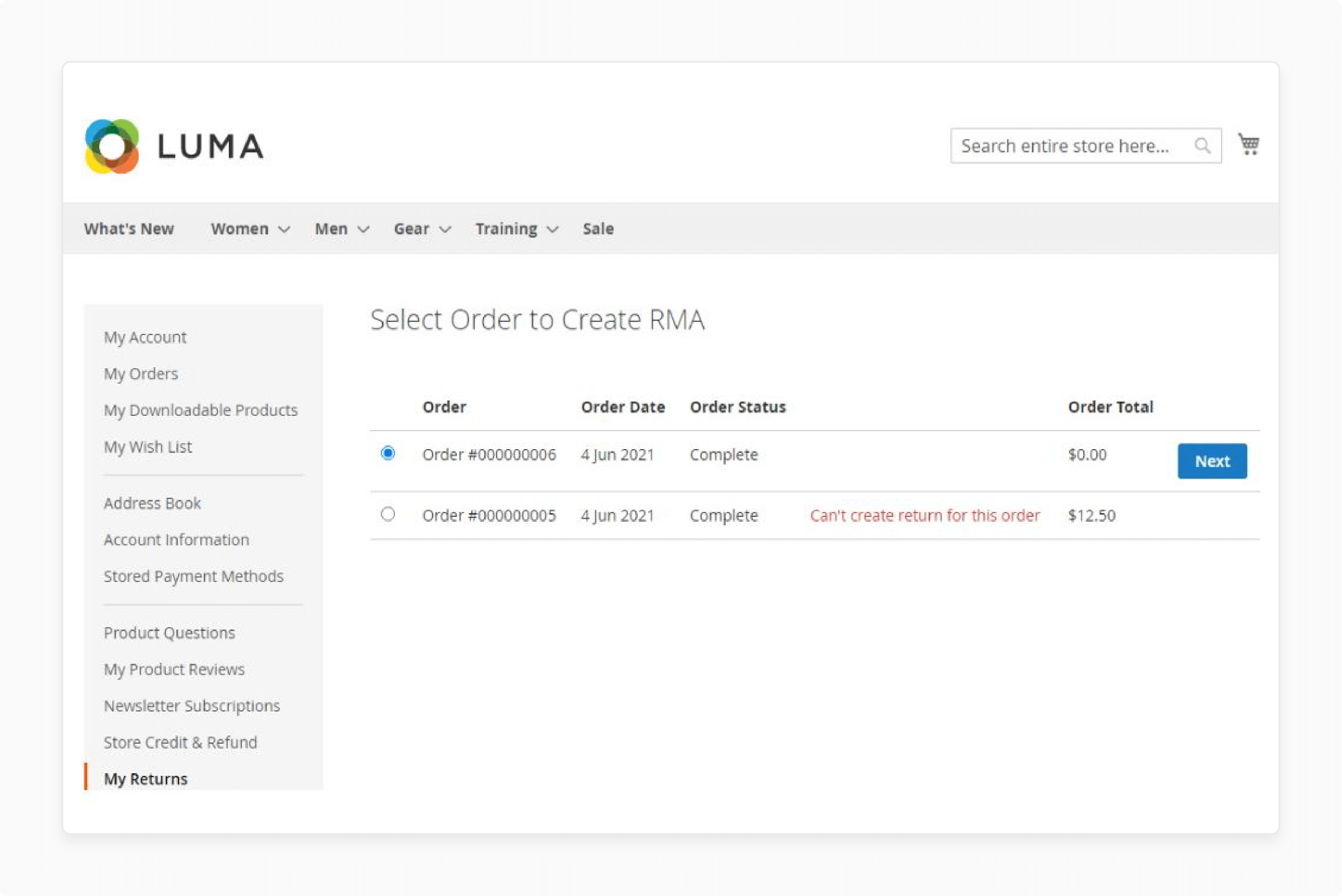
The extension simplifies the return process through:
-
A step-by-step wizard guiding customers through the return process.
-
Integration with order history, allowing customers to select items directly from past purchases.
-
Automated validation of return eligibility based on store policies.
For example:
A customer who bought a shirt a week ago can log in. They can select the order. They can choose the shirt. They can select a return reason from a dropdown menu. The system automatically checks if the return is within the allowed timeframe. It generates a return label if approved. It reduces the workload on customer service staff. It also minimizes errors in return requests.
2. Repair product errors
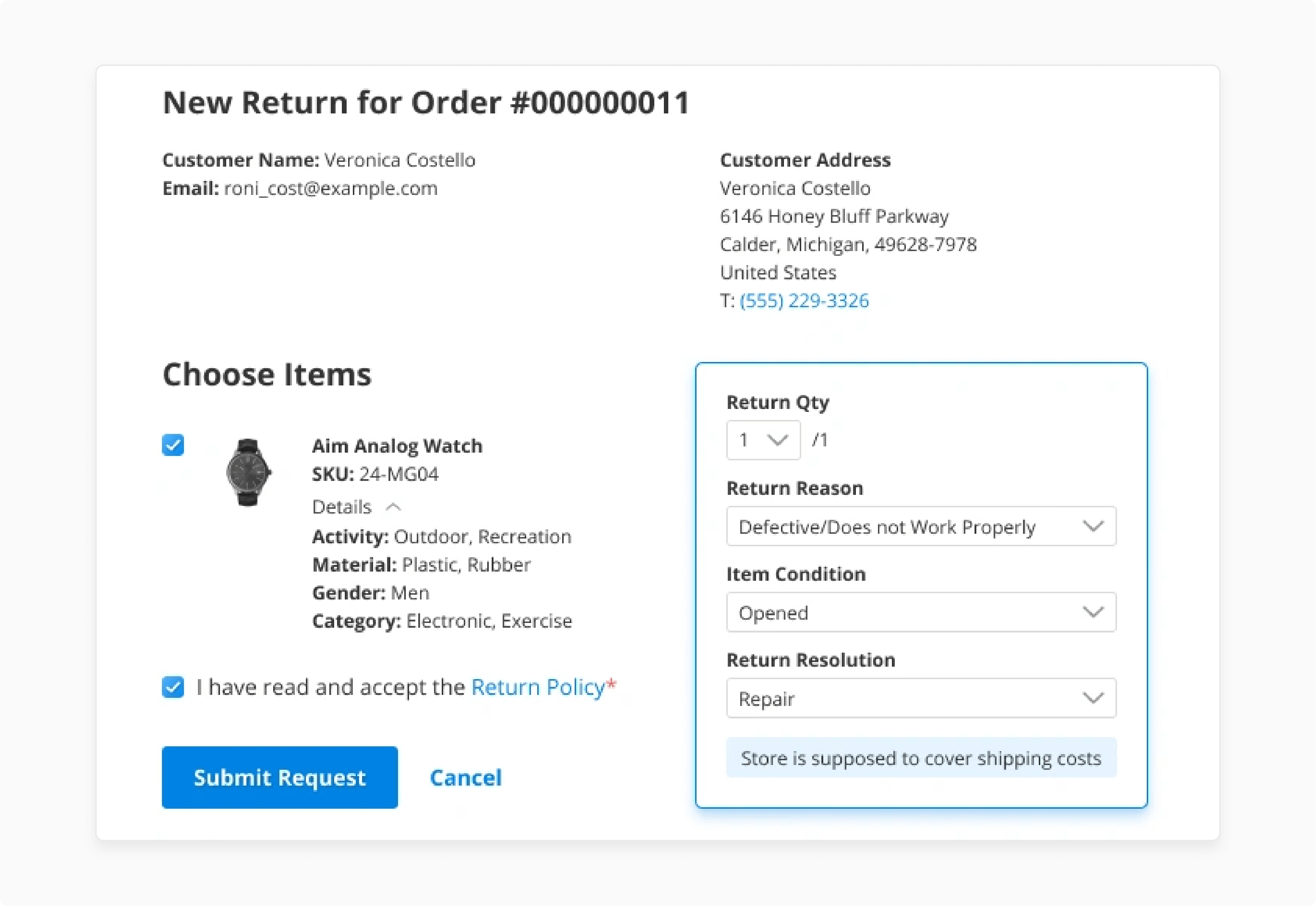
The RMA form for repair requests includes:
-
Detailed dropdown menus for common issues (e.g., "zipper broken," "button missing").
-
An option to upload photos or videos of the defect.
-
A text field for additional descriptions.
For example:
A customer with a malfunctioning blender can take several steps:
-
Select "Motor issues" from a dropdown.
-
Upload a video of the problem.
-
Add details about when the issue started.
This detailed information helps the repair team prepare in advance. It reduces turnaround time for repairs.
3. Exchange with another item
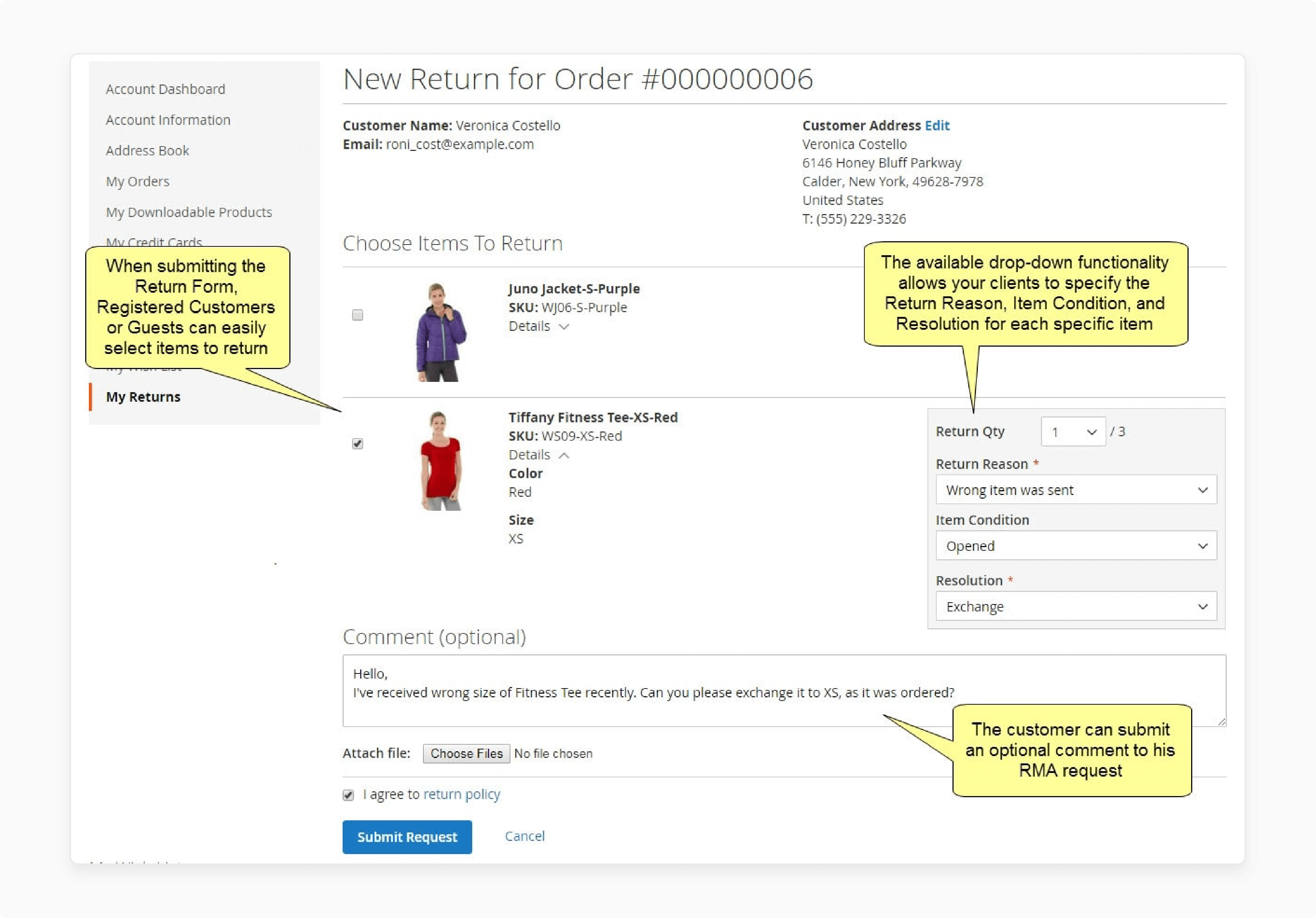
The exchange process is facilitated by:
-
Showing real-time inventory of available exchange options.
-
Calculating price differences for upgrades or downgrades.
-
Automatically updating inventory across all sales channels upon exchange approval.
For example:
A customer exchanges shoes for a different size. They see available sizes. They also see any price differences. They can complete the exchange in one transaction. This reduces the likelihood of exchanges being denied due to stock issues. It also streamlines the financial aspects of exchanges.
4. Refund in money or store credit
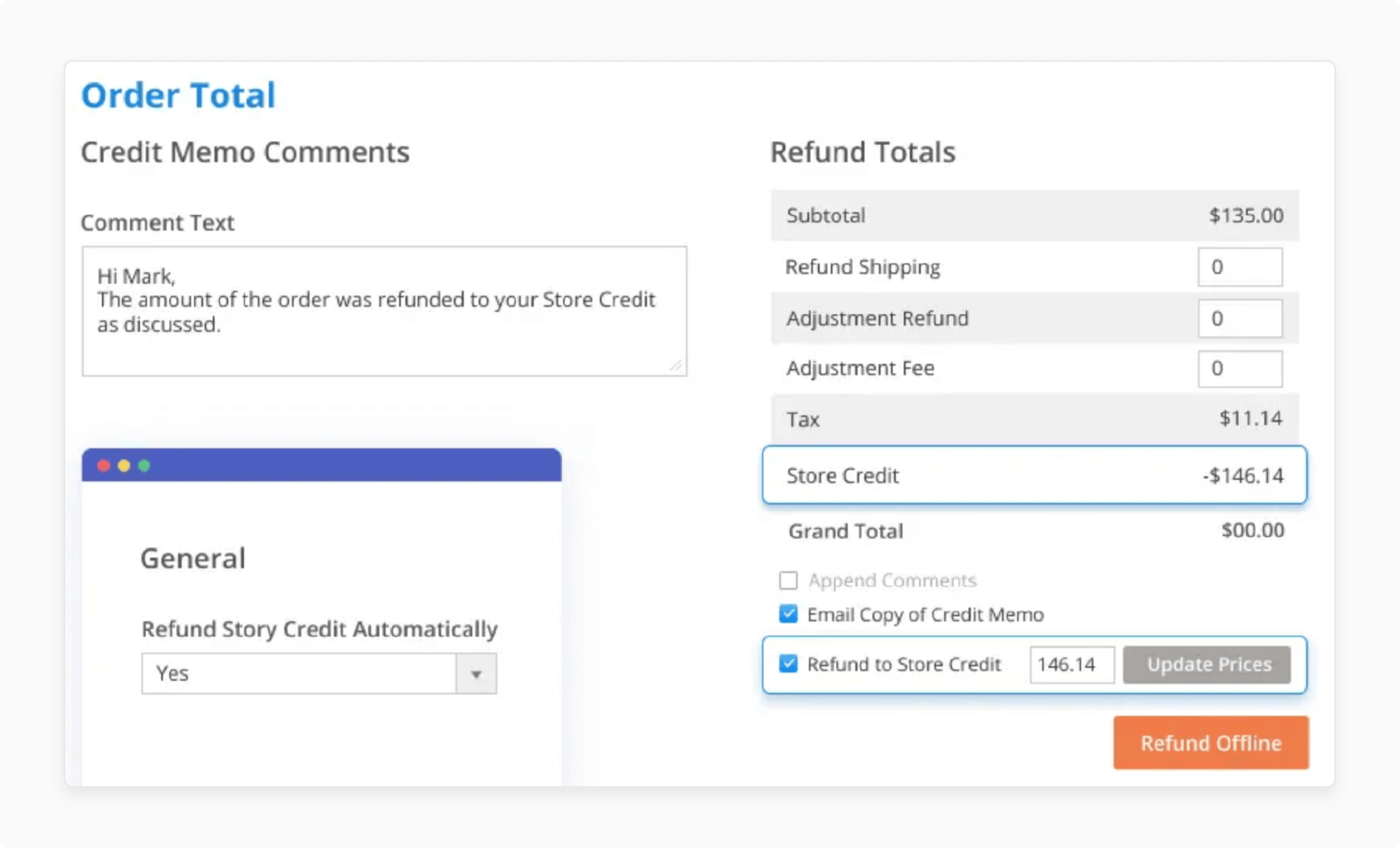
The refund system offers:
-
Instant store credit options, often with a bonus (e.g., 110% of refund value).
-
Integration with multiple payment gateways for direct refunds to original payment methods.
-
Options for partial refunds or combined refund types (part money, part store credit).
For example:
A customer returning a $100 item might be offered two options:
-
$100 cash refund.
-
$110 in store credit.
This incentivizes future purchases. This flexibility can turn a potential lost sale into future revenue. It also improves customer lifetime value.
5. Return requests for guests
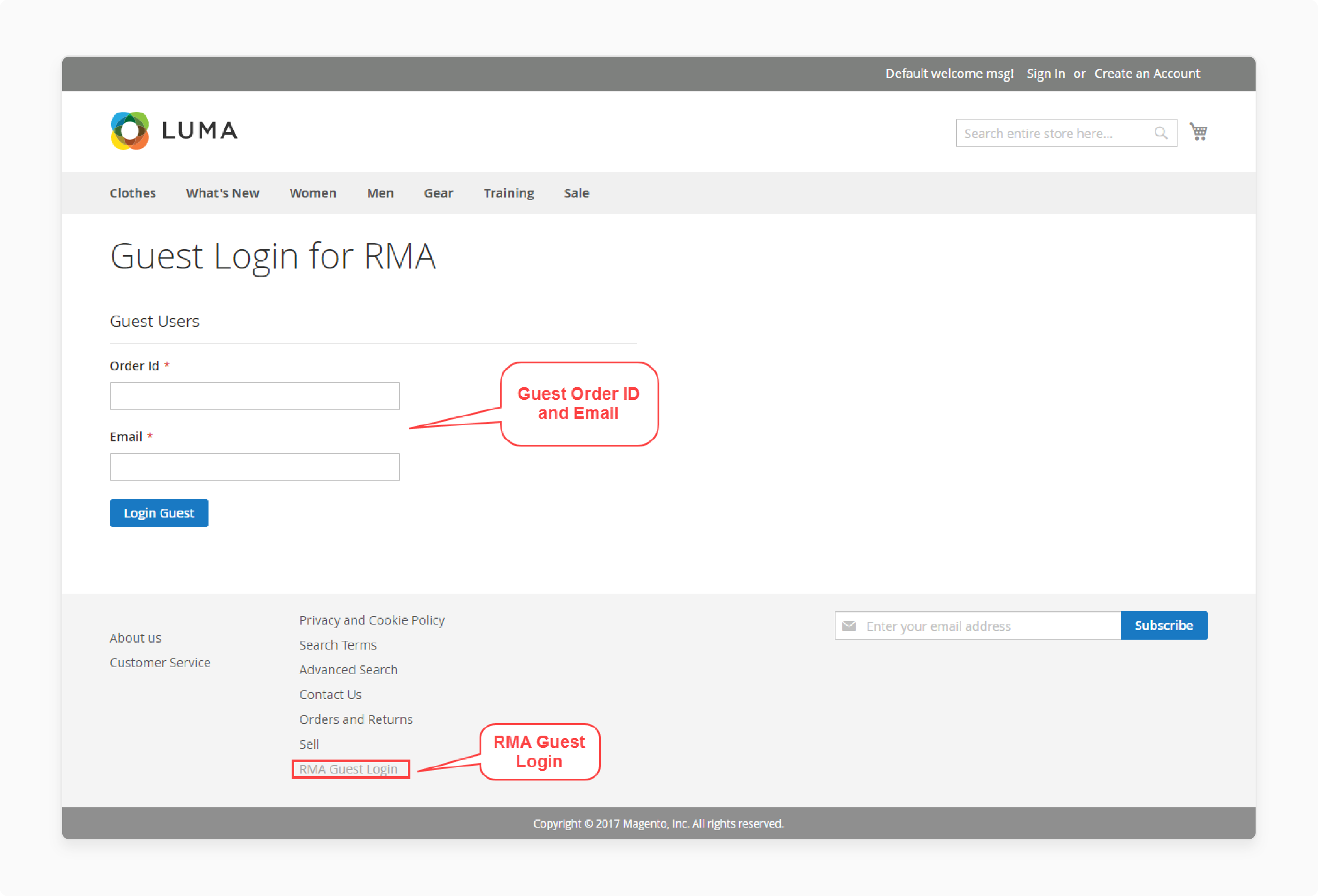
The guest return system includes:
-
Order lookup using email and order ID.
-
Optional account creation during the return process.
-
Same level of return options and communication as registered users.
For example:
A guest user who bought a gift can initiate a return using the recipient's email and order number. They don't need an account for this process. This ensures all customers have a smooth return experience. It potentially converts guest users to registered customers.
6. Limit products and orders qualified for returns
The admin panel for return policies allows:
- Setting different return windows for product categories (e.g., 30 days for clothing, 14 for electronics).
- Creating rules for non-returnable items (e.g., personalized products).
- Setting minimum order values for free returns.
For example:
An admin can set a rule for clearance sale items. These items are only returnable for store credit. The return window for clearance items is 14 days. Regular items have a different policy. They have a 30-day return window. Regular items can be returned for full refunds. This granular control helps stores balance customer satisfaction with business profitability.
7. Send emails to update RMA status frequently
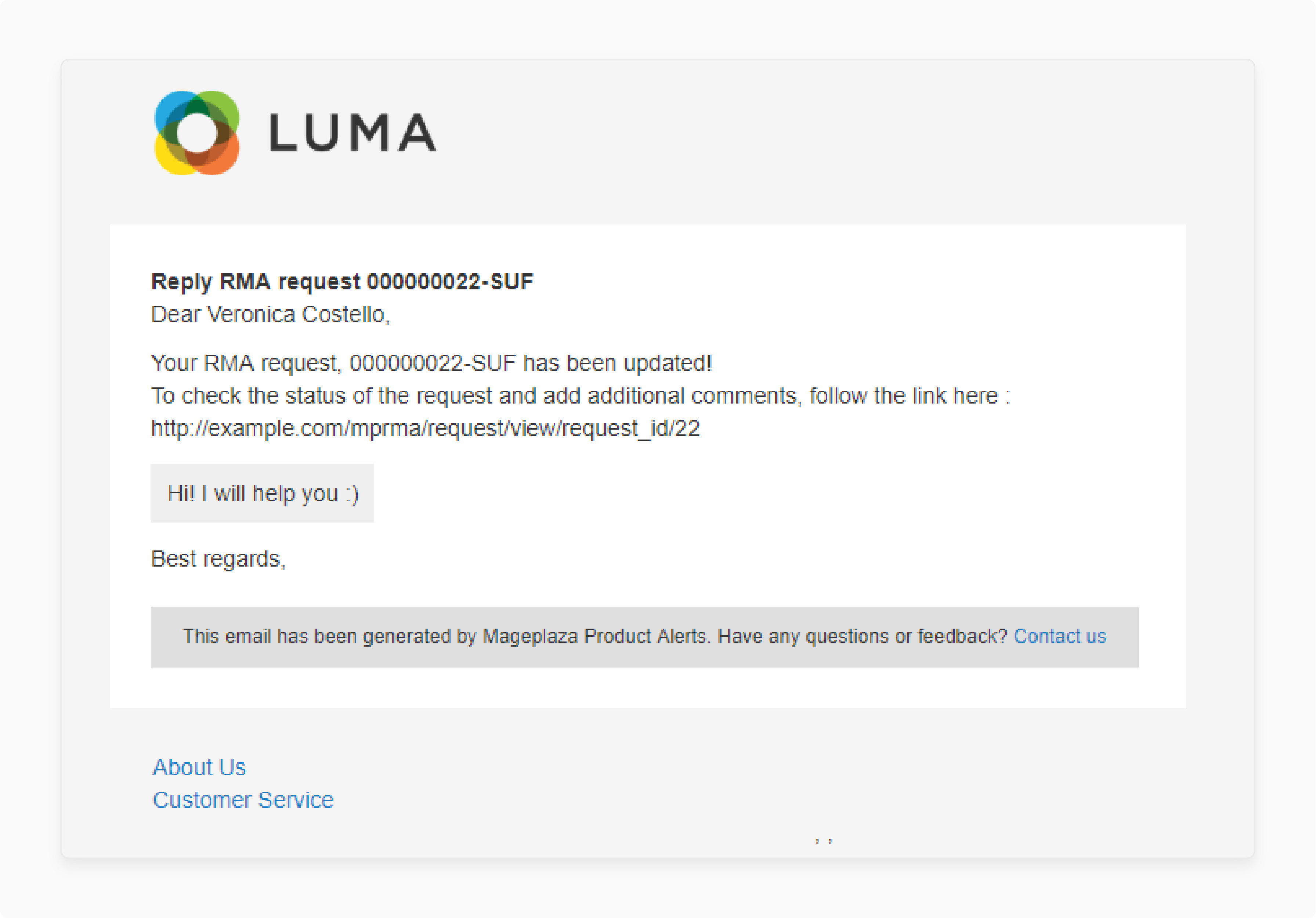
The email system includes:
-
Customizable email templates for each stage of the return process.
-
Triggered emails based on status changes (e.g., "Return Received," "Refund Processed").
-
Options for customers to reply directly to update emails.
For example:
When a return is received at the warehouse, an automatic email is sent to the customer. The email says:
"We've received your return. We'll process it within 2 business days and send you another update." This proactive communication reduces "where is my refund" inquiries. It improves customer satisfaction. It also reduces support workload.
Best Practices for Effective Magento 2 Returns Management
1. Clearly Communicating Return Policy to Customers:
| Practice | Description |
|---|---|
| Prominent Display | Show return policy clearly on your Magento 2 store. |
| Multiple Locations | Include return info on product pages and order confirmations. |
| Simple Language | Use easy-to-understand terms to explain the return process. |
| Key Points | Highlight important aspects like time limits and conditions. |
| Easy Access | Provide a clear path to the RMA request form. |
2. Offering Multiple Return Resolution Options:
| Option | Details |
|---|---|
| Varied Resolutions | Implement a Magento 2 RMA module with multiple resolution types. |
| Customer Choice | Let customers select refunds, exchanges, or store credit. |
| Repair Option | Offer repairs for eligible products. |
| Partial Refunds | Allow partial refunds in specific situations. |
| Return Methods | Enable both in-store and mail-in returns. |
3. Timely Processing of RMA Requests in Magento 2:
| Practice | Explanation |
|---|---|
| Automated Notifications | Set up automatic emails for new RMA requests. |
| Internal Timelines | Establish clear deadlines for processing returns. |
| Order Management | Use Magento 2's system to track and manage RMAs. |
| Streamlined Solution | Implement a dedicated returns management solution. |
| Regular Review | Periodically assess and improve return handling procedures. |
FAQs
1. What is the process of creating a return in Magento 2?
To create a return in Magento 2, customers can request an RMA. RMA stands for Return Merchandise Authorization. Customers can initiate this process through their order history. They select the product they wish to return, specify the reason for the return, and submit the request. The admin will then review the request and approve or deny it based on the store's return policy.
2. How can I manage product returns effectively with Magento returns module?
The Magento returns module allows you to manage incoming returns efficiently. It helps by tracking RMA requests, processing returns, and communicating with customers. Admins can review return requests within the Magento admin panel. They can approve these requests and update the status of the return process directly in the system.
3. What types of product return scenarios are supported by the Magento RMA extension for Magento 2?
The RMA extension for Magento 2 supports various return scenarios. These include defective products, wrong items sent, or products that customers simply no longer want. It also facilitates exchanges. Customers can request a different item in lieu of the original product.
4. Can customers initiate a return through the Magento store?
Yes, customers can initiate a return through the Magento store. Customers can access their order history. From there, they can request an RMA for a specific Magento 2 product. This process allows them to initiate returns. The system is designed to be user-friendly and efficient.
5. How does the return and exchange process work in Magento 2?
The return and exchange process in Magento 2 involves several steps. First, a customer requests an RMA. Then, the admin reviews and approves the request. After approval, the customer sends the product back to the store. For exchanges, the process is slightly different. If an exchange is requested, the admin can facilitate the replacement order. This is done through the admin interface.
6. How can I track the status of a return request in Magento?
Admins can track the status of return requests in Magento. They do this by navigating to the RMA management section in the admin panel. There, they can view all incoming returns. They can also see the current status of each return. Admins can view any actions needed to complete the return process.
7. How do I configure the RMA process in Magento 2?
To configure the RMA process in Magento 2, you can access the settings of the RMA module in the admin panel. Here, you can set up return policies. You can also configure notification settings. You can customize the workflow for processing RMA requests. These customizations can be made according to your store's needs.
Summary
Magento 2 Returns Management is designed to streamline the return process for e-commerce stores. This system enhances customer satisfaction and operational efficiency. It simplifies how returns, exchanges, and refunds are managed. Here's a recap of the essential points covered:
-
Streamlined Returns Management: Magento 2 RMA simplifies the entire return process. It ensures a seamless experience for customers. It also maintains accurate inventory levels.
-
Comprehensive RMA Management: The system allows for easy access and management of return requests. It improves communication with customers.
-
Automation and Accuracy: The RMA system uses automated sorting and reason codes. This reduces manual errors. It also speeds up processing.
Explore Magento hosting services to streamline performance with Magento returns management.





